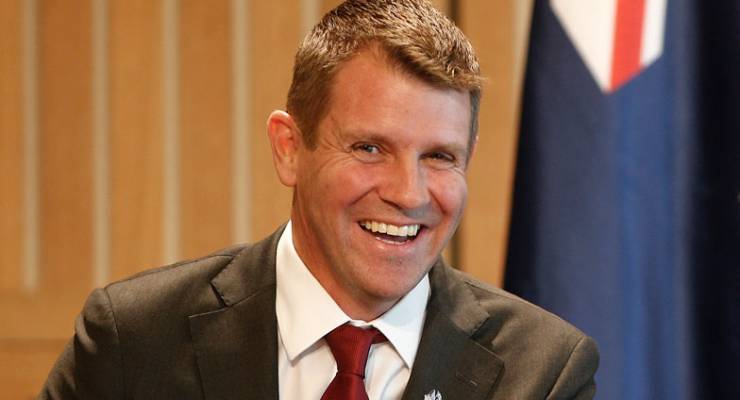
After three years of playing Mr Nice Guy, New South Wales voters are beginning to see the emergence of Mr Bad Guy. Premier Mike Baird’s popularity is dropping in the polls as his Teflon coating falls away. But why now?
When Mike Baird replaced Barry O’Farrell as NSW Premier in April 2014 the electorate saw a generational change and sniffed a social change as well.
First of all there was the “Baird” factor: his father, Bruce, had been a moderate and successful NSW transport and Olympics minister (1988-1995) before transferring his civic service ambitions to Canberra in 1998.
Before winning his home seat of Manly in 2007, Mike Baird had enjoyed a luminous career in banking; he was married to Kerryn, also a banker, and they had a young family of three.
This was the yuppie family from Central Casting. It brimmed with talent, energy and optimism, and the polls responded accordingly. Within months of replacing Barry O’Farrell, Baird was Australia’s most popular politician.
The March 2015 state election confirmed Baird’s popularity when he led the Coalition to a stunning victory after promising what was widely regarded as an electorally toxic policy — privatisation of the publicly owned electricity distribution system.
[Teflon Mike privatises poles and wires, makes bank]
The subsequent sale of the first network for $10 billion and a windfall from property sales worth another $6 billion had its own impact on Baird, his cabinet, backbenchers and the Coalition parties.
With an opposition that lacked cohesion or aggression, Team Baird collectively decided that they could do what they liked.
Urged on by Liberal Party’s hardliners from the “neo-con” faction, Baird unveiled a series of policies directly damaging community democracy, undermining civic rights and raising the cost of public services and the cost of living.
The government that promised “community consultation” became an administration of ultimatums and decrees. Councils were abolished, TAFE ransacked, more prisons commissioned and draconian legal attacks on civil liberties were dispensed, largely by press release.
[Are Sydney’s lockout laws killing nightlife or saving lives? Yes.]
There were fierce protests from organisations such as the Local Government and Shires Association, the Bar Council, Law Society, Teachers’ Federation, NSW Parks Association and many more. All of them were patronised or ignored.
The angry inner-city campaign against the WestConnex motorway is a classic example of the way the Coalition has bungled public concerns about the impact of one of Australia’s biggest infrastructure projects.
Its environmental and economic benefits have been trashed by faceless transport and Governor Macquarie Tower bureaucrats. Their arrogant message from the top is little more than “push on regardless and don’t let the greenies stand in our way”.
The same strategy was conducted against opponents of fracking and coal seam gas (CSG) exploration in regional NSW with disastrous political consequences. At the 2015 election the Nationals lost Ballina on the far north coast and held onto Lismore by their fingertips.
What’s happened since its re-election is that the NSW Coalition has paraded itself as little more than a front for developers, the NSW Police Association, the mining lobby and the corporate end of town.
While government process was conducted in much the same way under successive Labor administrations from 1995 to 2011 it was done under the counter or in back rooms. However, the Coalition is given to flaunting its big business connections and celebrating its essential function as the handmaiden of the CBD, declaring: “We’re open for business and good for business.”
This may have been a successful strategy for pro-business politicians such as Robert Askin, Nick Greiner and John Howard, but will it still be a serviceable election trick in 2019?
His other mistake was to pander abjectly to minor hard-right MPs in the upper house, promising major concessions in order to get legislation passed. Those IOUs to Fred Nile of the Christian Democrats and Robert Borsak of the Shooters and Fishers carry a redeem-by date, and Baird now finds his government hostage to reactionary fringe MPs, many of whom are working hand-in-glove with far-right Liberal dissidents.
[On the 2nd day of Christmas, Fred Nile gave to us, er, Boxing Day trading]
As reported Monday in Crikey, the latest Essential polling shows Baird’s huge lead over Luke Foley’s Labor opposition is fast collapsing. Earlier this year the Coalition was leading Labor 56%-44%; it then fell to 52%-48%; and is now around 51%-49%.
The Premier and his closest advisers — Clive Mathieson, director of economic, infrastructure and state priorities, and Imre Salusinszky, director of communications — seem to believe that a strategy of crash-through plus devious deal-making will suffice.
It may work for powerful media magnates, and it should be noted that Mathieson is a former editor of Rupert Murdoch’s flagship, The Australian, and Salusinszky is the paper’s former NSW state political editor.
But there is a vital distinction: Murdoch never had to stand for election. Baird does.








Crikey is committed to hosting lively discussions. Help us keep the conversation useful, interesting and welcoming. We aim to publish comments quickly in the interest of promoting robust conversation, but we’re a small team and we deploy filters to protect against legal risk. Occasionally your comment may be held up while we review, but we’re working as fast as we can to keep the conversation rolling.
The Crikey comment section is members-only content. Please subscribe to leave a comment.
The Crikey comment section is members-only content. Please login to leave a comment.